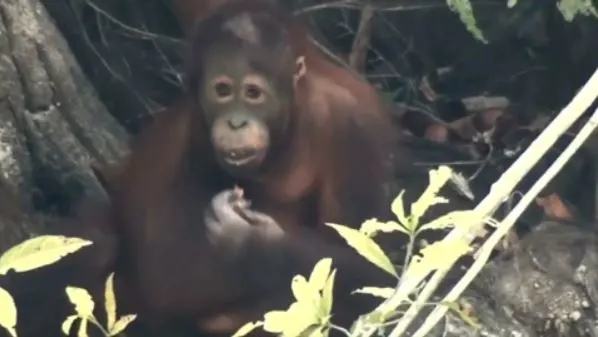
Orangutans suffering breathing issues as Indonesia wildfires burn
More than 300,000 hectares of land have burned so far this year.
On top of threats like poaching and habitat loss due to human activity and climate change, orangutans in Indonesia are suffering from breathing problems due to ongoing wildfires this season.
Dozens of the apes, which had been rescued from traffickers, were being prepared for re-release back into the wilds of Kalimantan, the Indonesian portion of the island of Borneo, when their caretakers noticed them struggling with the smoke.
"The smog has been going on for almost two months and because of that, some of our orangutans, especially those young ones, are starting to have respiratory tract infections, which was initially detected by symptoms of sneezing, coughing and flu," veterinarian Fiet Hayu of the Central Kalimantan Rehabilitation Program For Orangutans, told Reuters.
The affected individuals have been moved into closed facilities with cleaner air and are being monitored.
WATCH BELOW: BABY BOBCAT SURVIVES BUSH FIRE
READ MORE: Koala and joey recovering after being stranded by Australia bush fire
Hayu says the subspecies of orangutan native to Borneo, known as pongo pygmaeus, is particularly sensitive to changes in the atmosphere, with their young the most sensitive. They are considered a critically endangered species by the International Union for the Conservation of Nature.
Indonesia regularly sees forest fires, but this year's season has been one of the worst since 2015, with more than 300,000 hectares burning since January.
In Palangka Raya, the capital of the province of Central Kalimantan, schools have been closed this week and thousands of cases of respiratory illness have been reported.
WATCH BELOW: SCIENTISTS SAY THEY'VE DISCOVERED A NEW SPECIES OF PRIMATE IN INDONESIA
THOUSANDS OF FIREFIGHTERS BATTLE TO CONTROL THE FLAMES
Unlike in Canada, where most wildfires are started by lightning or accidentally by humans, this spate of fires in Indonesia has been largely human-caused. They're the result of slash-and-burn land clearances for plantations and farmland, made worse by drier-than-normal conditions due to an El Nino pattern, Reuters reports. The smoke is worst in Borneo and neighbouring Sumatra, but has afflicted much of southeast Asia.
Indonesian authorities have arrested 185 people in connection to the fires and deployed some 9,000 firefighters to bring the fires to heel, according to the AFP.
However, they face an uphill battle, and not just because of the dry conditions. The AFP reports many of the fires are burning in peatland, with combustible material extending underground, smouldering for some time after the surface fires have been extinguished.
READ MORE: One year on, B.C. wildfire still smoulders
“Even after we’ve managed to put out a fire on the ground, sometimes it is not over because it’s still burning underground. And then the next morning the ground fire will just reignite,” firefighter Hendri Kusnardi told the AFP.
Even worse, peatland fires have an even greater climate change effect than other kinds of forest fires, producing three times as much smoke, according to Greenpeace Indonesia activist Rusmadya Maharuddin.
"Sometimes the fires will continue to burn for months, releasing emissions and causing haze," she told the AFP.











